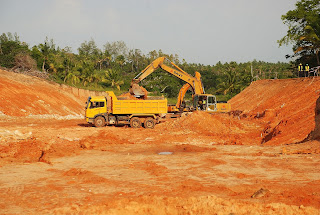 |
| Kenyan Highlands, centre of agriculture, Kenya's main export |
One of the oldest techniques used as a measure of economic performance is how much of sulphuric acid an economy produces and consumes. We use sulphuric acid in just about everything we consume. It is used in
batteries, paint, fertilizer, ore processing, steel production and water
treatment. It is a building block for a number of products like nylon,
we pickle our food with it. Thus, it is evident that sulphuric acid plays an important role in many manufacturing processes.
Hence, the more the production of sulphuric acid means the more the consumption
of it, which leads to high production rate of that country. This translates to more Gross Domestic Product and more Gross National Income for the country. In the USA it is the largest industrial produced chemical by volume.
In Kenya, there are two main manufacturers of sulphuric acid namely
Pan Africa Chemicals Ltd., formerly East African Heavy Chemicals, in Webuye and Kel Chemicals in Thika. There are other small producers like Orbit Chemical Industries. In 2002, Kenya produced about 20,000 t/yr of sulphuric acid for domestic industrial consumption. East African Heavy Chemicals in Webuye and Kel Chemicals Ltd. in Thika produced sulphuric acid from imported sulphur.
Since we have seen the relation between sulphuric acid production and GDP, let us look at the GDP indicators for the country. In 2011, Kenya's total GDP (by Purchasing Power Parity - PPP) was estimated to be $71.427 billion which translates to Per capita of
$1,746 leading to a worldwide ranking of 79 by IMF in 2011 and 78 by World Bank for the period between 2005 and 2010. Purchasing power parity (PPP) is a theory which states that
exchange rates between currencies are in equilibrium when their
purchasing power is the same in each of the two countries. This
means that the exchange rate between two countries should equal
the ratio of the two countries' price level of a fixed basket of
goods and services. When a country's domestic price level is
increasing (i.e., a country experiences inflation), that country's
exchange rate must depreciated in order to return to PPP.
 |
| Coal has been discovered in Kitui |
For the same year, 2011, total nominal GDP was estimated to be $34.796 billion which means Per capita GDP was $850. A measurement of "nominal GDP" from one year to the next simply adds up
total value of production without correcting for inflation.
Another indicator for development is the standards of living within the economy. Human Development Index (HDI) is used as a measure of quality of living standards in a country. It is a composite statistic used to rank countries by level of "human development", taken as a synonym of the older terms "standard of living" and/or "quality of life",
and distinguishing "very high human development", "high human
development", "medium human development", and "low human development"
countries. With a HDI of 0.509, Kenya was ranked as a low human development country in 2011 by UNDP, ranking at a lowly 142 worldwide, one position better than 2010.
 |
| Titanium deposits in Kwale, essential mineral in industrialization. |
If we look at the Production-Consumption Trend from a different angle of balance of trade in terms of exports versus imports, we might get a clearer dimension of the state of our economy. In 2010, Kenya imports stood at €11.2 billion (KES 1.2 trillion) compared to exports of €3.5 billion (KES 372 billion). This simply means the country spent almost 3 times more than it earned. This is a clear indicator Kenya is more of a consumer than it is a producer. This is especially evident when we take into account that about 60% of the exports were unprocessed agricultural and horticultural products and other raw materials. This means each year the country continues to ship money out of its economy in order to pay for the imports that cannot be covered by export earnings. This is a retrogress to the economy and a major hindrance to growth.
In conclusion, Kenya can only be a prosperous country if and only if, it becomes more of a producer and less of a consumer. Local manufacturing and processing will create employment locally and selling of the products will bring about earnings into the economy through exports. Wages and salaries paid to employees ensures that the money remains in circulation within the economy and is not shipped out through imports. When that's the scenario, truly, we'll see a shift to the country's standards of living for the better.
No comments:
Post a Comment